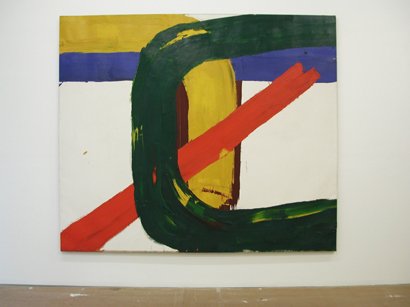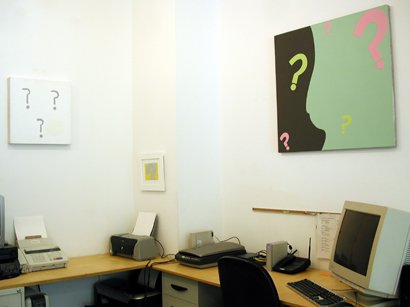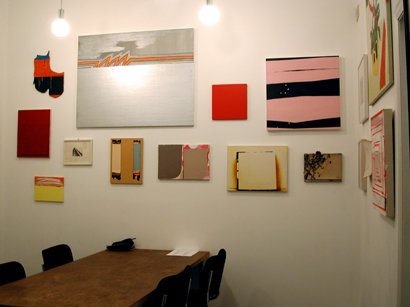STUDIO SHOW 2006
Exhibition at reedstudio, June 17 and 24, 2006
When Guy Goodwin re-stretched his painting C-Swing (1974) at my studio earlier this year it looked so good, that we decided to have a little show of his work. In the office, to keep his paintings company, Ulrike Müller has installed my collection of question mark paintings and Dean Daderko has selected an illustrious group of lunch guests.
In the Front Studio: Guy Goodwin
C-Swing (1974), Spine (1978), Olive Oil (2006)
C-Swing, 1974
Oil on canvas
89 x 103 inches
Spine, 1978
Oil on wood
45 x 50 1/2 inches
Interview with Guy Goodwin and David Reed
David Reed: Guy, how did you make the painting in this exhibition?
Guy Goodwin: I would collect and amass big mounds of paint, three feet in diameter, each on a sheet of plywood, covered with plastic. Usually a painting took five or six moves, one a day, each from a different pile. I knew that I had to set aside a week when I wouldn’t be interrupted. If I ran out of a color, and you know, my funds were limited, the painting would die.
DR: So each of those big marks…
GG: …took a day.
DR: Would you go back into a mark from the previous day again?
GG: No. I would put it down and that would be it. The next day would be the next mark. The painting was painted while upright. I had to get all the color up there in those trails, and get it to feel right.
DR: It took you a whole day to make one mark?
GG: It might look like you just went across the surface once, but there was a lot more to it than that. As the painting built up, as the paths crossed each other, there was more and more paint up on the surface. I didn’t want it to be spilling down into the open areas, so I had to really be in control. It was a matter–of–fact kind of thing — keep all the material moving. It was really just a kind of a task. That’s the only way I can put it. There are eight of those paintings. It took almost a year to do them all because I had to work and collect the paint. I could do about one painting a month. It was all very methodical. When the paintings started to percolate there would be a feeling of magnification, that’s the main thing I remember. That’s the strange power of these paintings. The sensation was that I was making small marks — just magnified way up. I always had to keep the mark from spreading, so it would remain a mark.
DR: These paintings are so in your face — no messing around. They seem somehow to be an answer to the disparaging, critical attitude towards painting at the time. Do you remember that?
GG: Absolutely! Are you kidding, man? Painting was thought to be a waste of time, a joke. Come on, you know that; so many people felt that way, absolutely. But then I was interested in those ideas. They seemed to have some kind of resilience. They made sense in the face of the war in Vietnam. In those days everything was being questioned. I wanted to find out why people thought that way. I was tortured by it…but it was silly to say that a process and material were exhausted. Painting is just a medium, using a neutral material. Sometimes illusion was questioned. But what isn’t illusory? That just didn’t make sense. Maybe it would have been better to say: “Art is over.” Yes, art was threatened. It’s always threatened.
Olive Oil, 2006
Acrylic and paper on plexiglass
65 x 55 x 4 inches
Olive Oil (detail), 2006
Acrylic and paper on plexiglass
65 x 55 x 4 inches
Installation view
Olive Oil (detail), 2006
Acrylic and paper on plexiglass
65 x 55 x 4 inches
Installation view
In the Office: Too Many Tear Drops
Too Many Teardrops
by Gregg Bordowitz
Where mood becomes the most significant
Among material properties’ weight
The question is a nagging discomfort
A kvetching uncle; an annoying child
A quote in the book shelved too high, unreached
A chair grabbed to stand–on, old, rickety
Poor solution to the problem of reach
Of touch, of claiming the provisional
The answer to a question now forgotten
Gone by the time what’s needed is at hand
A punctuation that refuses to attach
Adhere to any one sentence
Promiscuous and willing to append
Adores all wanting more than just one
More than the mere air of utterances
A densely textured repetition
The urgent signal of a woolly stitch
A single sock of laundry day despair
The what–comes-–next? pointing outside the seam
It pulls all into itself, a vortex
A swirl. The outer limit of a gyre
Curved and interrogatively bending
Bent over the lap of a drunken salesman
Seductive or blunt, thick and weary
Made tumescent by an inviting query
An exclamation point trying to stand
Where voice ascends in anticipation
Awaiting sturdier punctuation
Sturdy but not necessarily stiff
The spiral motion of cupidity
Always ambivalent, demanding more
Without the certainty of periods
Or a semi–colon’s inclusiveness
The question mark is an aspiration
Beholden to painters who worship marks
Marks as a matter of embodiment
Drowsy with ontological burdens
Anxious inveterate practitioners
Of a method so often questioned to death
As if painting has to have the answers
As if the work of art must mean something
Mean something more than the fact that it is
Is something, like everything, made by doubt
Checklist:
Scott Reeder
Why?, 1995
Acrylic on canvas
18 x 18 inches
Jessica Diamond
Cloud that is a Question Mark (#3), 2001/02
Acrylic on paper
5 x 6 13/16 inches
Carl Ostendarp
Untitled, 1994
Polymer latex on linen
31 1/2 x 33 inches
Al Ruppersberg
What Should I Do?, 1988
Silkscreen on glass
22 x 14 inches
Al Ruppersberg
Why Do We Fail?, 1988
Silkscreen on glass
22 x 14 inches
Richard Artschwager
Question Mark, 2001
Iris print
19 x 15 inches
Serpentine Gallery edition
Ulrike Müller
Live the Questions Now, 2005
Sequins on felt
12 x 6 inches
with portfolio 11 x 8 1/2 inches
Richard Allen Morris
Untitled, 1966
Gouache on magazine page
11 x 8 1/4 inches
Michael Reafsnyder
Huh?, 2005
Acrylic on linen over panel
14 x 18 inches
Rosa Hanna Scott
Life?, n.d.
Acrylic on canvas
25 x 19 inches
Guest who’s coming to lunch? Works from David Reed's collection, curated by Dean Daderko
Robert Barry, Stefan Eins, Rochelle Feinstein, Pam Fraser, Jeff Gauntt, Ron Gorchov, Mary Heilmann, Christine Heindl, Jasmine Justice, Lee Lozano, Klaus Merkel, Richard Allen Morris, Laura Owens, Blinky Palermo, Ruth Root, Al Ruppersberg, Alejandra Seeber, Haley Tompkins, Nicholas Wilder
Over the six years that I worked with David Reed as his studio assistant, there was one thing all of us at the studio looked forward to daily—lunch! We sat down together as a studio to eat and, most importantly, talk. We talked about shows we were working on, shows we had seen, other artists, ideas. We debated, complimented and challenged each other, all in a spirit of open dialogue.
During lunchtime conversations, David introduced me to the work of artists like Lee Lozano and Richard Allen Morris, both of whose works are represented here. One of his concepts that intrigued me was the way he looked at Lee Lozano’s multi–part paintings as “interior shaped canvases.” I’ve taken his idea to heart, and it informs this exhibition, which considers the interior and exterior lives of paintings. These works offer a broad menu of “possibilities for painting,” another topic we often discussed. Rochelle Feinstein’s painting offers us a space for projection of our imaginations, a painting for us to mindfully complete. Hayley Tompkins works question painting’s physicality as much as its visuality. And Richard Allen Morris offers us endless surprises and innovation—a finger–painting like no other, and paintings expanding beyond their physical limits of their stretchers.
Everyone contributed to this engaging, ongoing conversation. I ’m pleased to be able to include a painting by Jasmine Justice in this exhibition an artist whom I worked alongside and shared inspiring lunchtime conversations with. Guests often came to lunch, too—visiting artists, curators, collectors, friends. Some made informal presentations about their work. We grew close to many of them. I’m particularly happy to be able to include paintings by Alejandra Seeber, Klaus Merkel and Ruth Root, who have helped me to look at paintings with new eyes.
The paintings I selected from David's collection for this lunchroom show represent a guest–list of sorts; these artists were all present in person and/or in our conversations around the table. I hope that it may provoke some new debates, as well as new insights, both for the studio crew, and for its visitors.
-Dean Daderko, June 2006
Checklist:
1. Hayley Thompkins
Saint, 2003
Watercolor on board
2. Hayley Thompkins
Untitled, 2001
Watercolor on paper
3. Klaus Merkel
Stack/David Reed, 2003
Oil and cement on linen
4. Mary Heilmann
Rompecabeza Dos, 2000
Acrylic on wood
5. Jeff Gauntt
To See Inside, 2000
Acrylic and enamel on wood
6. Richard Allen Morris
Honeypenny, 2000
Acrylic on canvas
7. Lee Lozano
Untitled, n.d.
Graphite on paper
8. Pam Fraser Unitled (Zig Zag), 1997
Acrylic and gouache on wood
9. Richard Allen Morris
Untitled, 1988
Acrylic on canvas
10. Ruth Root
Untitled, 1999
Oil on canvas
11. Robert Barry
Untitled, 2001
Pencil and acrylic on canvas
12. Rochelle Feinstein
Before and After #1, 1999
Oil on linen
13. Jasmine Justice
Calamity Jane, 2005
Acrylic and oil on canvas
14. Richard Allen Morris
Vagabond’s Joy, 1983
Acrylic on canvas on canvas
15. Stefan Eins
Untitled, 2001
Paint on wood
16. Blinky Palermo
Projektion, 1971
4-color Offset print on board
17. Laura Owens
Untitled, 1998
Mixed media on paper
18. Ron Gorchov
Untitled, 1973
Graphite on canvas
19. Alejandra Seeber
Hut Necklace, 1998
Oil on canvas
20. Christine Heindl
TGIF, 2000
Acrylic and collage on canvas
21. Nick Wilder
Wish, 1985-86
Oil on rag paper on linen on panel
22. Al Ruppersberg
Honey I rearranged the collection in memory of Nick Wilder, 2000
Pastel, pencil and silkscreen on paper
















